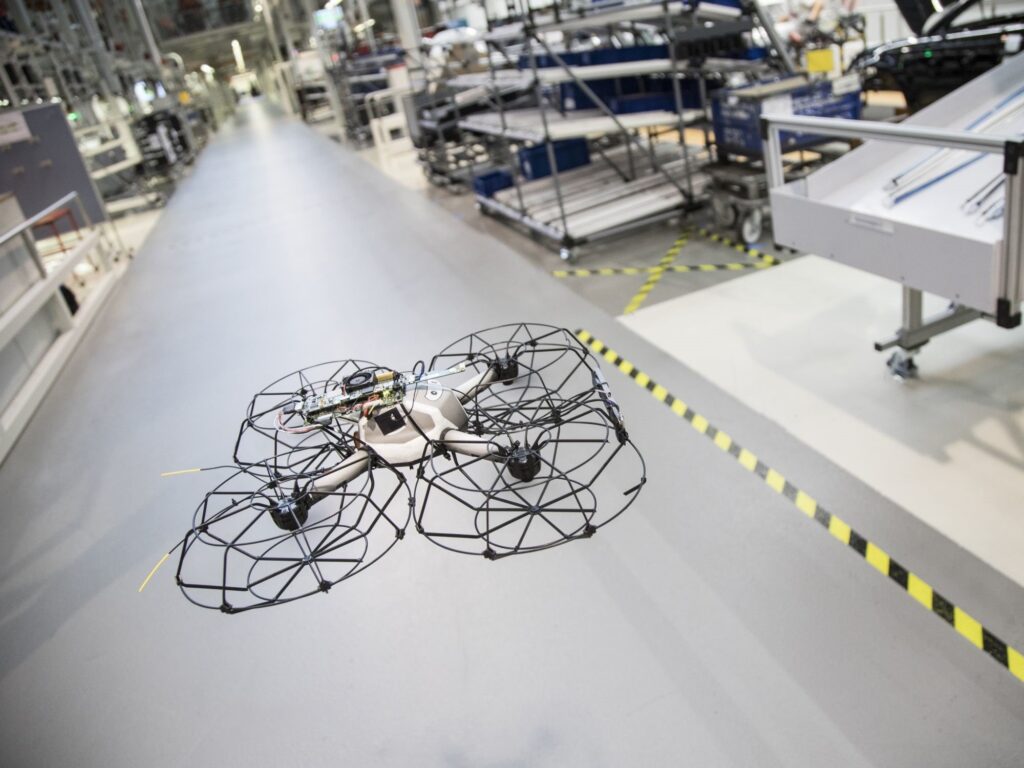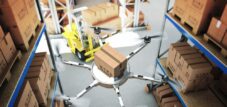Testing the agile aircraft in production and storage
Drones in production and logistics are a well-known topic. However, the focus is usually on transporting goods. Almost everyone is familiar with the countless stories about Amazon's plans to build a fleet of drones for package delivery or the use of drones for outdoor monitoring of goods flows. But drones are equally well-suited for use inside buildings.
It's not just logistics professionals who believe that drones are best suited for outdoor use. However, there are many compelling reasons to fly them indoors as well. Their agile flight characteristics allow drones to operate in confined spaces, making them ideal for use in warehouses or assembly halls. Their advantage is obvious: while there's often heavy traffic on the floor of a hall, the airspace above is largely unobstructed. This makes it a logical choice for rapid deliveries to the production line or for other tasks.
Spare parts transport to the assembly line
A reliable spare parts supply is the foundation of any efficient production process. To minimize machine downtime and the resulting production losses, speed and a smooth flow of materials are crucial. The rapid and efficient transport of required parts by drone helps to successfully meet this challenge. This is especially true when parts are distributed across different, dynamic storage locations. Where humans or AGVs quickly lose track or require unnecessarily long travel times, these intelligent transport systems fly directly to the desired parts and deliver them as quickly as possible to where they are needed.
One advantage of drones is that they can be controlled remotely using mobile devices. If the pilot also uses virtual reality glasses for support, they can access a wide range of additional information via the display. Control is also simplified, as the pilot can simply move the drone into the desired position and direction by moving their head or changing their gaze, thus leaving their hands free.
The car manufacturer Audi is testing drones at its Ingolstadt plant to explore the feasibility of transporting parts to the assembly lines during ongoing production. The initial idea was to enable faster delivery by air compared to floor-based transport vehicles. The drones are now flying along a defined test track at approximately 8 km/h through the halls during the production of the A3 and Q2 models. The drones have a payload capacity of 2 kilograms. Larger payloads are technically feasible, but would directly impact the drone's dimensions. Especially in confined spaces, it is crucial to keep the systems as small and maneuverable as possible.
The drones are currently controlled manually by pilots, but their potential clearly lies in automated applications. Corresponding trials have already taken place in Audi . If such tests prove successful, drones could in the near future not only supply Audi's assembly line with urgently needed spare parts, but also, with the help of their cameras, perform or monitor general maintenance and repair work.
Use of drones in the warehouse
Thanks to rapid technological advancements, drones of all sizes are now available for a wide range of applications. This includes small devices that, despite their compact dimensions, possess sufficient payload capacity to transport objects or be equipped with high-resolution cameras and scanning technology. As a result, drones are increasingly suitable for use in warehouses, where they can easily navigate the often narrow and tall aisles of shelves.
Especially in high-rise systems, drones reduce the risk of employee injuries from working at heights. Human-machine collaboration is helpful here, where the warehouse is divided into different zones: While employees perform tasks at floor to chest height, the drones operate in higher aisles.
Drones also offer advantages for other warehouse management tasks. A good example is inventory. Normally, stock levels are checked and counted manually by employees. However, to minimize downtime, this task must be carried out alongside daily operations. Often, this is only possible by working overtime outside of normal business hours – with productivity-reducing factors such as overtime pay and the risk of increasing inaccuracies due to staff fatigue.
Drones can streamline the inventory process and allow it to be carried out at night or on weekends, minimizing downtime. During their flights, the devices use cameras and scanners to record existing stock and check it.
Simultaneously, the inventory is taken and the results are reported directly to the inventory management system. Employees thus relieved of this task can dedicate themselves to other, more demanding duties, and it is ensured that inventory levels are recorded continuously and accurately throughout the year.
Linde Material Handling, in collaboration with the French company Balyo has developed a system specializing in automated inventory using drones . The so-called Flybox was presented at LogiMAT 2017 in Stuttgart and is designed to significantly simplify inventory processes, saving companies valuable time and money. The drone, approximately 50 centimeters in size and equipped with a camera and barcode scanner, operates fully automatically, enabling inventory counts outside of regular working hours.
outlook
Whether for transporting goods and conducting inventory in warehouses or supplying spare parts to production and assembly – the use of drones inside buildings is on the rise. But as with so many innovations, this trend also requires certain prerequisites: For maximum efficiency, the aircraft are not controlled manually, but by software that assigns individual drones their tasks and routes and ensures that the small transporters do not collide with each other, other objects in the warehouse, or even people. Why shouldn't it be possible in the near future for these systems to develop their own swarm intelligence and – similar to what AGVs are already demonstrating in some warehouses and production facilities – communicate autonomously with each other and distribute tasks to complete them efficiently and quickly?
This requires a modern IT infrastructure and a fundamental willingness to invest in innovative technology. Therefore, drones will likely only be of interest for larger storage capacities, at least in the medium term. However, given the intense competitive pressure in this market, the productivity achieved with these flying helpers could easily determine success or failure.


